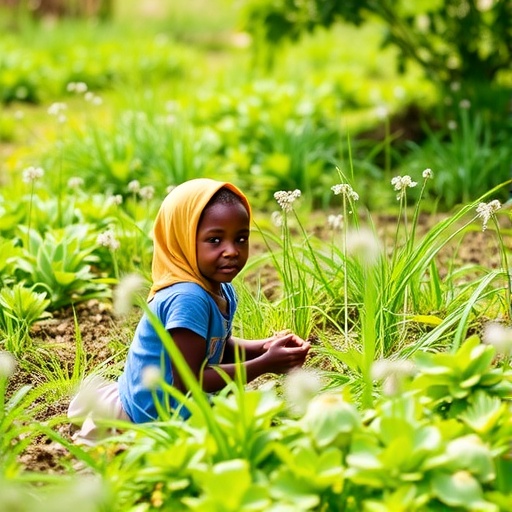Irrigation has long been hailed as a linchpin for agricultural development, promising enhanced food production, improved nutrition, and strengthened rural economies. Yet, recent research by the United Nations University Institute for Water, Environment and Health (UNU-INWEH) challenges this optimistic narrative by revealing a paradoxical and potentially alarming trend in the Global South. Despite irrigation’s association with better child nutrition, these benefits disproportionately occur in regions already grappling with critical water scarcity, raising pressing questions about the long-term sustainability of such interventions.
Drawing upon an extensive dataset encompassing over 70,000 households across 26 low- and middle-income countries, the study reveals that irrigation expansion between 2000 and 2015 correlates strongly with increased dietary diversity among children under five years old. Dietary diversity here acts as a proxy for micronutrient intake and overall nutritional status, which are crucial indicators of early childhood health and development. The findings validate the notion that irrigation can improve food availability and dietary quality, especially in subsistence farming communities.
Crucially, however, the research uncovers a sobering catch: about 36% of these irrigation-driven nutritional improvements occur in areas where water use had already exceeded the region’s renewable freshwater supply. This indicates a model of agricultural expansion driven by irrigation that may be extracting beyond the ecological limits of local water systems. The intensified withdrawal of water resources in such zones risks undermining the very foundation of agricultural productivity and societal well-being in the medium to long term.
Dr. Marc F. Müller, lead author and Associate Research Professor at UNU-INWEH, highlights this dilemma: while irrigation does boost child diets and therefore human wellbeing, the improvements may be fleeting if water overuse precipitates environmental degradation. “We find ourselves confronting a trade-off,” he explains. “Immediate nutritional gains are counterbalanced by heightened water stress, mandating a rethink of how irrigation-driven development unfolds in vulnerable regions.”
The study’s methodological innovation lies in its integration of high-resolution irrigation mapping with geospatially referenced household nutrition surveys—allowing a nuanced dissection of irrigation’s impacts on diet quality across diverse hydrological regimes. This level of spatial and thematic granularity enables the identification of where irrigation operates as an inclusive tool against malnutrition, and where it may instead reinforce inequities or environmental risks.
Interestingly, the data illuminate contrasting patterns of irrigation use in water-stressed versus water-abundant regions. In locations burdened by water scarcity, smallholder farmers tend to harness irrigation to nurture staple crops essential for local food security, which directly benefits child nutrition. Conversely, in water-rich areas, irrigation is often channeled toward cultivating high-value export-oriented cash crops such as coffee, soybeans, and palm oil. These cash crops generate economic returns but produce limited nutritional spillovers for the surrounding populations, underscoring a disconnection between agricultural investment and local dietary outcomes.
The findings complicate conventional assumptions about irrigation as a straightforward panacea for hunger and malnutrition. They emphasize the necessity for context-sensitive approaches that prioritize not just agricultural yield but also equitable and sustainable nutritional outcomes. Policymakers and development practitioners are therefore urged to embed water sustainability and nutrition metrics at the core of irrigation planning, ensuring benefits reach vulnerable groups like children, women, and marginalized communities.
By highlighting that roughly two-thirds of children surveyed still fail to meet the Food and Agriculture Organization’s minimum dietary diversity standards, the research underscores the vast scope of unmet nutritional needs despite irrigation’s advances. This gap serves as a stark reminder that irrigation expansion alone is insufficient without complementary measures addressing broader socio-economic and environmental determinants of nutrition.
Moreover, the study challenges development agencies to reorient irrigation projects towards locally consumed, nutrient-rich crops rather than export commodities that bypass local food systems. This strategic shift could help maximize irrigation’s positive spillover effects on child nutrition while mitigating water resource depletion risks.
The environmental sustainability dimension cannot be overstated. In many developing regions, water resources are under intense pressure from competing demands. Amplifying irrigation without rigorous ecological safeguards risks locking communities into a precarious cycle of resource depletion and food insecurity, undermining the aspirations embodied in the Sustainable Development Goals (SDGs)—notably SDG 2 (Zero Hunger), SDG 6 (Clean Water and Sanitation), and SDG 1 (No Poverty).
In light of these findings, the authors advocate for integrated frameworks that explicitly bridge water management, agricultural development, and nutrition outcomes. Such synergy is crucial to optimizing resource use and securing sustainable health and food security advances, particularly in vulnerable contexts typified by water stress.
Ultimately, the UNU-INWEH Policy Brief serves as a clarion call to reassess irrigation’s role in development. It encourages scientists, policymakers, and practitioners to adopt a more critical, systems-level perspective—one that acknowledges the complex interplay between water availability, crop choices, economic incentives, and nutritional benefits. Only through such a holistic lens can irrigation be harnessed effectively to nurture thriving, resilient communities without irreparably compromising precious water resources.
As irrigation expansion continues across the Global South, the urgency to balance nutritional gains with environmental sustainability and social equity grows ever more paramount. This insightful research charts a path forward, inviting stakeholders to rethink conventional wisdom, embrace nuanced data-driven strategies, and place child nutrition and water stewardship squarely at the heart of irrigation-led agricultural transformation.
Subject of Research: The relationship between irrigation expansion and child diet diversity in the Global South, analyzed in the context of regional water stress and agricultural practices.
Article Title: Child diet diversity and irrigation expansion in the Global South
News Publication Date: 24 June 2025
Web References:
References:
Müller M. F., Mehta P., Niles M. T., Madani K., Davis K. F. (2025). Expanding Irrigation Could Enhance Child Nutrition but Risks Unsustainable Water Use, UNU-INWEH.
Mehta, P., Müller, M.F., Niles, M. T., & Davis, K. F. (2025). Child diet diversity and irrigation expansion in the Global South. Nature Sustainability.
Keywords: irrigation, child nutrition, dietary diversity, water stress, sustainable agriculture, Global South, food security, water resource management, micronutrients, agricultural policy, Sustainable Development Goals, environmental sustainability




